Due to the constant rise in the cost of traditional energy sources, heating installations that burn wood, coal and other types of fuel are becoming more widespread. The owner of a private house, who has decided to purchase such a product for heating, needs to create conditions for its normal operation. To ensure stable combustion and efficient removal of flue gases, a good chimney for a solid fuel boiler is required. It plays an important role, especially in cases where the unit is not equipped with forced air supply devices and the combustion process depends on the natural draft created by the chimney.
Laying of chimneys from bricks or prefabricated metal chimneys, prefabricated pipes with a chimney or fireclay ceramic insert, stacks of prefabricated steel chimney inserts. Masonry chimneys Stone chimneys are the most commonly used system for removing flue gases from solid fuel... A serious disadvantage of brick chimneys is that they cannot be used to discharge wet exhaust gases such as flue gas or fuel oil due to the condensation phenomenon on the walls of the chimney. This has a significant effect on the destructive effect of condensate and the dissolution of limestone or lime-cement mortar.
Types and a short description of chimneys
Flue gas discharge devices differ into several types in terms of design and type of execution:
- Brick vertical ducts built into the inner wall of the house together with ventilation shafts. This also includes new types of built-in ducts - ceramic rectangular gas ducts.
- Chimneys attached to the outside of the wall of the house. Also made of red ceramic bricks.
- Vertical metal pipes running inside the building with access to the roof.
- Steel pipes for the removal of combustion products, located outside the cottage. They can be attached to a wall or to a free-standing lattice mast made of rolled metal.
In houses built of bricks or blocks, ducts for ventilation and removal of combustion products are provided in advance by the project. Most often, a brick chimney for solid fuel boilers is arranged in the inner wall of the building, adjacent to the furnace room. In older houses, you can find gas ducts attached to the outer wall and resting on a separate foundation.
Users of heating equipment must also ensure that heating devices burn a suitable fuel for combustion, especially in order to avoid burning wet wood, wet coal and the combustion process, which must be carried out with proper air supply.
Each user must ensure that the heat output of the heater matches the technical parameters of the chimney. Metal chimneys This exhaust technology uses metal inserts or metal chimneys to remove wet exhaust gases. Depending on the chemical composition chimney cladding can be used chrome or chrome-nickel steel. The most common applications have been made with austenitic stainless steels. It is a steel alloy containing chromium, nickel and molybdenum.
The disadvantages of brick diverters are as follows:
- The inner surface of the brickwork consists entirely of irregularities and roughness, contributing to the intensive deposition of soot on them from the combustion of solid fuels.
- The rectangular design of the chimney has inferior aerodynamic characteristics in comparison with the round one and increases the resistance to the flow of gases, the force of natural draft is lower.
- Brickwork, attached outside the house, due to the temperature difference, begins to separate from the wall and a crack appears between them. If the extension was laid out later than the main construction proceeded, then the crack width may be even greater due to the foundation settlement.
- Condensation formed on the walls of the masonry penetrates into the pores of the material and, under the influence of low outside temperatures, destroys it. The result is shown in the figure.
![]() A vertical chimney made of ceramic bricks is quite suitable for connecting a solid fuel boiler, since it is durable and in good harmony with the exterior of a brick mansion. To eliminate its inherent disadvantages, it is necessary to modify the design of the gas duct or to execute it correctly even at the construction stage, which will be discussed below.
A vertical chimney made of ceramic bricks is quite suitable for connecting a solid fuel boiler, since it is durable and in good harmony with the exterior of a brick mansion. To eliminate its inherent disadvantages, it is necessary to modify the design of the gas duct or to execute it correctly even at the construction stage, which will be discussed below.
Austenic steels are characterized by high mechanical strength and high corrosion resistance due to alloying additives, especially for corrosion caused by acid reactions in combustion products. The advantage of a steel chimney is that it heats up quickly and therefore operates at the correct stack temperature close to the flue gas temperature, thereby minimizing the occurrence of condensation and condensation from the flue gases, obtaining high energy efficiency of the chimney and chimney, protecting the surface from corrosion.
Construction of two steel pipes with a layer of insulation - this is a modern correct chimney... It is assembled from separate sections with a length of 1-2 m, which are lightweight, so even one person can do the job. The inner part made of stainless steel is smooth, soot does not settle on it, and condensate flows freely into the lower part of the structure, from where it is easily removed through a special pipe.
Heat-resistant steels such as chromium, nickel and silicon are highly resistant to hot gases and combustion products. These chimneys are specially designed for the discharge of flue gases from wood chips, such as open fireplaces and closed combustion chambers, devices for heating wood pellets from wood waste.
V recent times commercial chimneys are made of heat-resistant steel chimneys of this type. This steel creates a passive layer that provides the inner surface of the chimney. Manufacturers also offer metal chimneys chimneys, made of ferritic steel, in which the main alloying additions are chromium and additives, molybdenum, titanium and niobium. Ferritic steels, despite their poor functional properties, a number of properties that determine their widespread use in the art of chimney, due to the fact that the material is a ductile and efficient mechanism and has a high long service life.
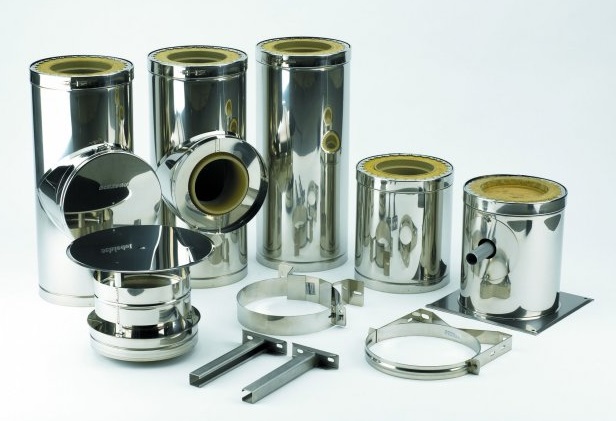 One of the latest technical solutions for the removal of waste gases is a metal coaxial chimney. The principle of its operation is that combustion products exit through the internal section, and air from the street enters the combustion chamber through the space between the walls. Such air ducts are allowed to be used in conjunction with heating units, in which such a possibility is provided. As a rule, these are installations with forced air injection and a closed firebox. To make sure of this, it is imperative to study the technical data sheet for the product.
One of the latest technical solutions for the removal of waste gases is a metal coaxial chimney. The principle of its operation is that combustion products exit through the internal section, and air from the street enters the combustion chamber through the space between the walls. Such air ducts are allowed to be used in conjunction with heating units, in which such a possibility is provided. As a rule, these are installations with forced air injection and a closed firebox. To make sure of this, it is imperative to study the technical data sheet for the product.
The temperature class, the tightness class, the resistance to condensation, the corrosion resistance and the fire resistance of the soot must also be considered to ensure the safety of the heating devices. Fairy Tales, Petr Chembala Association of Polish Chimneys. Requirements for metal chimneys.
What are the advantages of a ceramic chimney? The use of a ceramic chimney design greatly simplifies the installation of single and multi-channel designs - exhaust and ventilation. Such chimneys can be installed not only during the construction of a house, but also later in the case of modernization works. They do not require a separate support and can also be ceiling based. The big advantage of these flues is that they are available in prefabricated blocks for easy installation.
It is better to improve the existing brick chimney for a solid fuel boiler by taking a number of measures. One of them - the sleeveing of the mine, is done with the aim of:
- change the rectangular section of the channel to a round one and thereby improve its aerodynamic characteristics;
- make the inner walls of the flue smooth to prevent soot from settling;
- additionally insulate the space between the round sleeve and the square opening and protect the material from the effects of condensation.
The essence of the event lies in the fact that a round metal pipe of the corresponding diameter is inserted into the rectangular channel along its entire height. On the side, 2 holes are cut out in it, one above the other, the first is for connecting the outlet from the boiler, and a hatch is mounted in the second - revision. To avoid the ingress of precipitation, the outlet is closed with a decorative umbrella, a deflector - a spark arrester or a rotating weather vane. Insulation, usually basalt wool, is stuffed into the cavities formed between the round pipe and the rectangular channel.
Finished chimneys can be added to an external or internal wall, and insulated chimneys can be installed outside the building as a stand-alone device. Ceramics, the internal components of such pipes are made of steel or fireclay ceramics and therefore they work with oil boilers and gas are highly resistant to condensation. On the outside of the enclosure, prefabricated chimney manufacturers offer lightweight concrete or ceramic components.
Ceramic chimneys can be single-channel for exhausting flue gases or have a design that also includes a ventilation duct. This second solution is especially advantageous when the chimney is to interact with a fireplace or a boiler located in a separate boiler room.
The destruction of the material of the walls of the mine from the effects of condensate is possible by insulating them from the outside with plates of basalt fiber 80-100 mm thick. If the channel is located in the inner wall of the house, then it is necessary to insulate its upper part, which is located in an unheated attic and above the level of the roof. Attached smoke shafts should be lined with heat-insulating material as a whole, sheathing the insulation from the outside with galvanized metal 0.5 mm thick.
When installing a prefabricated chimney, the elements of the inner gasket are first connected, and then, when heated, the segments of the outer casing are assembled. This chimney is best bought with a tee to connect the duct to the boiler and with a shutdown. If such a chimney is placed inside the house, and its ceramic cladding does not match the decor, it can be covered with drywall or plaster. The protruding roof can also be plastered, but it will be more durable, such as clinker tiles.
If you are using bricks to build a chimney, you will need to use a roof for them. Such a base plate can also be purchased as a prefabricated element, as well as hatches that cover the top of the chimney. What are the advantages of a steel chimney?
Performing a brick chimney device in order to connect a solid fuel boiler to it, you can use modern ceramic materials. They are rectangular blocks, inside of which a circular channel is made.
 The main shaft is assembled from such blocks to remove combustion products, and from the outside it is lined with masonry made of decorative stone such as "bassoon" or another, depending on the exterior of the cottage. In this case, additional insulation is not required.
The main shaft is assembled from such blocks to remove combustion products, and from the outside it is lined with masonry made of decorative stone such as "bassoon" or another, depending on the exterior of the cottage. In this case, additional insulation is not required.
In this case, two solutions are available. Steel insert - which can be placed in an existing brick chimney or ventilation duct. As an independent design in several versions. The flue gas components are made of acid-resistant steel. Depending on whether the chimney will come out of gas boilers or whether it will work with a solid fuel boiler, the pipes have different wall thicknesses and are made from different grades of steel.
The chimney insert can be rigid - then the pipe is inserted into the existing chimney if it is straight and without any bends or elastic - you can also insert the pipe into a channel with a greater curvature. A separate steel chimney is usually a single-channel structure designed to discharge flue gases from gas, oil, solid fuel or wood burning fireplaces... It is suitable for indoor or outdoor installation... It is lightweight, so it does not require a special backrest in the form of a foundation - a bracket or stand is enough.
Since ceramic blocks and their installation are not cheap, a cheaper option can be used during construction - to make the same sleeve metal pipe with insulation.
Calculation of the distance and height of the chimney
During construction, the height of the chimney for a solid fuel boiler must be maintained in accordance with regulatory documents. The stable operation of any heating installation that burns coal or wood depends on this. The required height provides the natural draft force to create a vacuum in the furnace of the unit, and also dissipates the combustion products in the atmosphere. The requirements of regulatory documents apply to all types of pipes, regardless of what material they are made of. There is a chimney scheme for a solid fuel boiler, which must be adhered to during construction:
They are basically similar to rigid chimney liners, but differ in how they are supported and fixed. The chimney is equipped with mounting brackets, supports and a roof overhang. The individual pipe sections are connected with a socket or with a clamp. A single wall chimney can only be installed inside the house.
For safety reasons such a structure is covered with thermal insulation and, for example, plasterboard, gypsum fiber or brick walls with aerated concrete. It can also be left uncovered as a decorative element of the interior - thus, chimneys usually come out from the center of the fireplace.
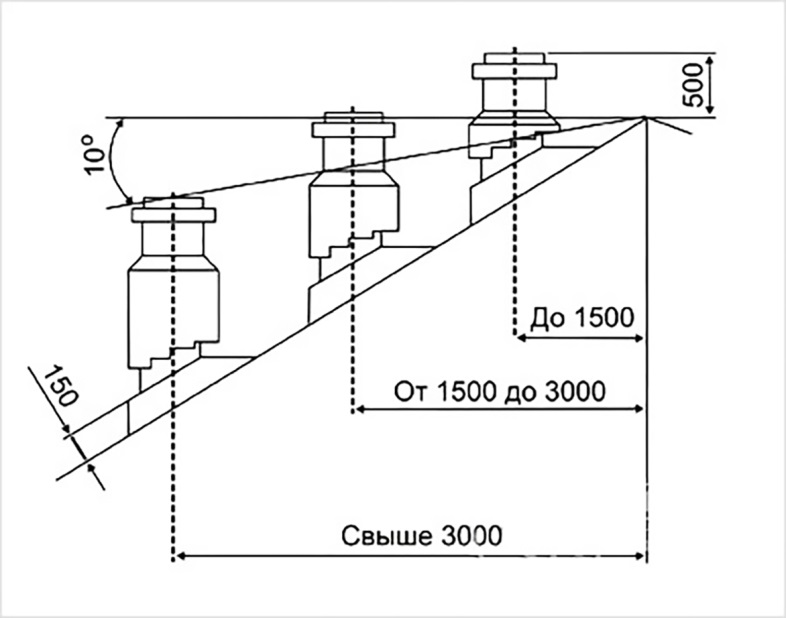 As an example, it is proposed to consider a design scheme with the following initial data:
As an example, it is proposed to consider a design scheme with the following initial data:
- the height of the building in the ridge is 6 m;
- the distance from the smoke exhaust device to the ridge is 6 m.
Of course, open pipes increase the efficiency of heating, but you must remember that in this case, safety - at least 30 cm must share the chimney from any flammable elements of home and construction equipment. They are adapted for outdoor installation. And it owes its construction - an internal combustion pipe, thermal insulation and a second pipe made of stainless steel or aluminum. This chimney is convenient when the boiler is located in a place where it cannot be connected to an existing chimney or ventilation duct.
It happens that everything is done correctly and the end of the pipe is at the required height, but there is still no draft in it, the boiler plant cannot function normally. The reason may be simple: there is a taller structure next to your house, or the cottage itself has a complex multi-level shape and your gas flue has fallen into the zone of wind support.
But this, of course, is not the only argument in favor of the solution of such a chimney - it is so attractive that it can be made from an architectural element of a building block. Double-walled chimneys are fixed to the wall with clamps and console support.
It is also equipped with a drainage system and a condensate drainage system. At the top of such a chimney there is a so-called. a mouthpiece to be covered with a rain cap, and preferably a rotating chimney hood. They also have a very interesting design. This is because, in addition to the exhaust gas, they also supply the air necessary for the operation of boilers with a closed combustion chamber and condensation.
Calculating the wind pressure zone is very simple: draw an imaginary line from the highest point of the building to the ground at an angle of 45 degrees, as shown in the diagram.
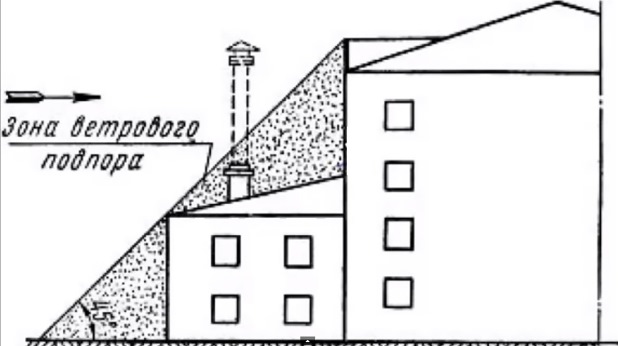 In this zone arises high blood pressure and the traction will be very weak, the end of the shaft will have to be raised half a meter above the imaginary line. In order to avoid wind back pressure, regulatory requirements have also been written, according to which it is necessary to maintain an angle of 10º at a distance of more than 3 m from the ridge of the roof.
In this zone arises high blood pressure and the traction will be very weak, the end of the shaft will have to be raised half a meter above the imaginary line. In order to avoid wind back pressure, regulatory requirements have also been written, according to which it is necessary to maintain an angle of 10º at a distance of more than 3 m from the ridge of the roof.
In short, this design can be defined as a “pipe in a pipe” - the exhaust pipes are drained by an inner pipe, and in the space between the pipes, fresh air enters the boiler burner. The exhaust pipe prevents the exhaust gases from being released at the outlet.
Air outlet pipes can be run over the roof or through the wall of the house. This second solution comes in handy when we don't want a traditional looking chimney. But of course the flue gas can also be inserted into a traditional multi-channel chimney or installed separately.
The advantage of combustion air ducts, which cooperate with closed cell boilers, is that the combustion process is completely separated from the air inside the house. This means that there is no need to install additional boilers in the boiler, and there is no danger of gas entering the room, and the preheating with the extract air increases the efficiency of the boiler itself. The possibility of this solution limits the length of the wires and the formation of too much resistance to flow. This length depends on the type, power and power of the installed blower.
One of the main conditions is that the diameter of the chimney of a solid fuel boiler must be no less than the outlet for exhaust gases of the installation itself. Otherwise, there is a lack of gas duct throughput when the unit is operating at medium and maximum power, which is unacceptable. If the shape of the vertical shaft is rectangular, and the outlet for gases from the heater is round, it is necessary to compare them with each other in the area of the flow area.
On the Polish market we have a large selection of different flue systems. With regard to technical issues, we can say that the technologies we use do not differ from those that exist in the West. Moreover, due to the fact that coal fuel is still popular in Poland and, unfortunately, the practice of using stoves as waste disposal equipment is quite common, the requirements for chimney installations are often significantly higher than those of our neighbors.
The advantages of steel chimneys at a glance? Possibility of use in case of repairing brick chimneys. ... The acid resistant smoke insert can be installed in an existing building, its design is light, and the modular installation system allows the installation of an “overhead” cartridge with minimal damage to the building.
When connecting a solid fuel boiler, make sure that the length of the chimney at its outlet is at least two diameters before the first turn, and the latter is as small as possible along the entire length of the flue. Each turn creates additional flow disturbance and turbulence, causing increased local drag. Accordingly, the traction force deteriorates.
In order for the flow of gases passing through the circular cross-section of the chimney to flow smoothly into the vertical shaft, it is better to place the horizontal section from it to the heating installation at an angle. Ideally, this angle is 45º, however, this is not always possible, therefore a value of 30 or even 15º with an inclination towards the unit is acceptable. If the latter is equipped with a blower or a smoke exhauster, then the observance of the slope becomes not so important, since the combustion products are thrown out forcibly.
Conclusion
Parameters such as the height and size of the chimney for solid fuel boilers have great importance for their further comfortable operation. The best thing that can be done is to work out this issue at the stage of building design, in extreme cases - during construction. It will be more difficult to eliminate the consequences of flaws and will be more expensive
People need warmth - this is how nature works. V apartment buildings this problem is being addressed by the appropriate structures. When building a private house and outbuildings on a site, responsibility for the warmth and comfort is assigned directly to the owner himself, that is, many owners install a heating unit with their own hands and independently arrange a chimney for a solid fuel boiler.
For the full and safe operation of the boiler, it is necessary that the chimney is correctly installed (see Installation of chimneys). For example, a solid fuel boiler requires air to work, which must enter the equipment through special openings. After the fuel has burned out, the flue gases must be removed from the boiler. For this, there is a chimney for a solid fuel boiler. Let's figure out whether it is possible to implement a chimney for a solid fuel boiler with our own hands.
Chimney draft
Draft is the main parameter of the chimney. It reflects the speed of movement of flue gases. As you know, thrust arises due to the temperature difference (warm air rises) and the pressure difference in the room and outside, therefore, such parameters as the height and cross-section of the pipe directly affect the draft, this must be taken into account when planning the construction of a chimney with your own hands ..
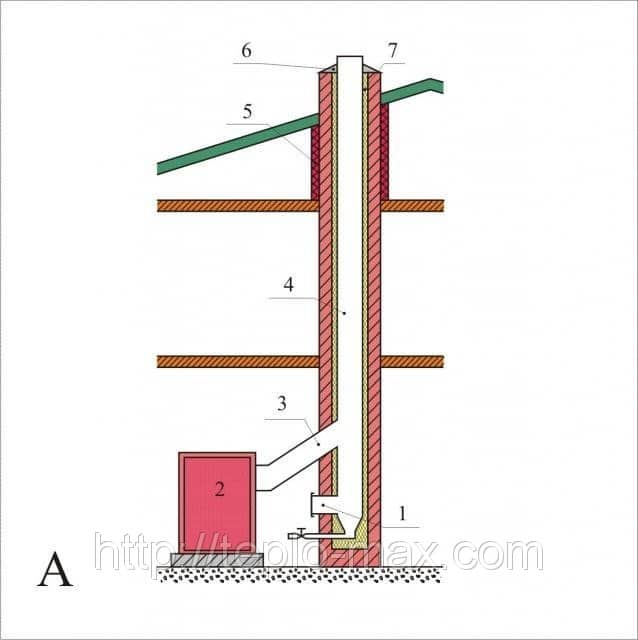
Other properties of solid fuel boilers
The properties of heating units are unstable, this must be taken into account when planning to build a chimney for a solid fuel boiler with your own hands.
They are unstable because they directly depend on unstable factors: temperature of flue gases, air, direction and strength of wind, etc. Also, the properties of a solid fuel boiler are affected by the fact that the combustion of fuel in them is uneven. Thus, the temperature of the flue gas entering the chimney for a solid fuel boiler is not constant. In units powered by wood, it reaches 70-300 ° C, and in coal-fired boilers - 400–600 ° C.
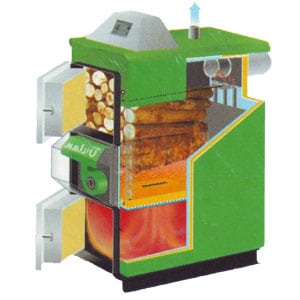
It should be borne in mind that during the ignition of the boiler, the temperature rises sharply, and after the start of operation in standard mode, it decreases, and these factors also affect the intensity of the draft.
Parameters influencing the boiler operation
- One of the important factors affecting the operation of the chimney of a solid fuel boiler is the height of the pipe, that is chimney length
... The explanation is simple: on straight sections, the flow of flue gases picks up speed. The cross-section and smoothness of the chimney walls are also important. Below are the parameters that are critical for effective work chimney:
- To- absolute outside temperature;
- g- acceleration of free fall;
- Ti−average internal temperature (K);
- A- cross-sectional area of the pipe (m2);
- h- pipe height (m);
- Q- air flow, (m³ / s);
- C- coefficient introduced due to friction (0.65–0.70).
- Of no small importance is also chimney design for a solid fuel boiler. The fewer horizontal and narrowed sections, turns, the better the traction. This is explained by the fact that the flue gas flow rises along the pipe along a spiral path. Encountering obstacles on its way in the form of roughness, seams, etc., the flow changes direction, and gases are mixed.
Chimney temperature resistance
As already described above, the flue gas temperature can fluctuate within 70–600° C , therefore, the factor of heat resistance of the chimney is important. Today, various materials are used in the construction of chimneys, the best are steel, ceramics and refractory bricks. In very rare cases, glass chimneys are also installed.
Ceramic chimney
Ceramics is an excellent material if you are building a chimney for a solid fuel boiler (see Ceramic Chimneys for Chimneys). Ceramic flues have the following properties:
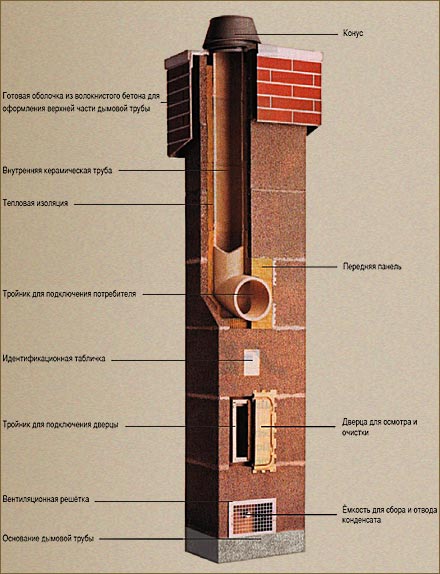
Chimneys for solid fuel boilers made of ceramics can be installed both indoors and outdoors.
Stainless steel chimney
Metal chimneys for solid fuel boilers are made of stainless and black steel (see Stainless steel sandwich chimneys). Products made of black steel are becoming less and less popular, as they are unstable to the effects of aggressive media: soot and condensation. Chimneys made of stainless steel contain additives of molybdenum, titanium, nickel and others chemical elements... For solid fuel boilers, steel 316, 316 L, 321 and some others are used. The composition of these grades of steel allows them to withstand temperatures up to 700–800° C ... A stainless steel chimney is a durable, reliable and inexpensive option.
Refractory brick chimney
Chimneys, pipes and other products made of this material can withstand temperatures up to 1000 ° C... Refractory bricks have a large set of positive properties, however, the manufacture of a chimney from this material for modern solid fuel boilers is undesirable. The walls of a brick chimney take a long time to heat up, which leads to the formation of condensation.
Chimney for a solid fuel boiler: installation rules
General Provisions
- Installation and installation of boilers must be carried out in strict accordance with the regulations and rules of fire safety.
- The optimal section and height of the chimney is selected in accordance with the instructions provided by the equipment manufacturer.
- The maximum length of horizontal sections should not exceed one meter.
- The chimney height is selected according to the manufacturer's recommendations (or should be no more than five meters).
When installing a chimney with your own hands, be sure to take into account that its device must allow condensate to drain, clean the pipes from soot and carry out maintenance.
Chimney connection rules
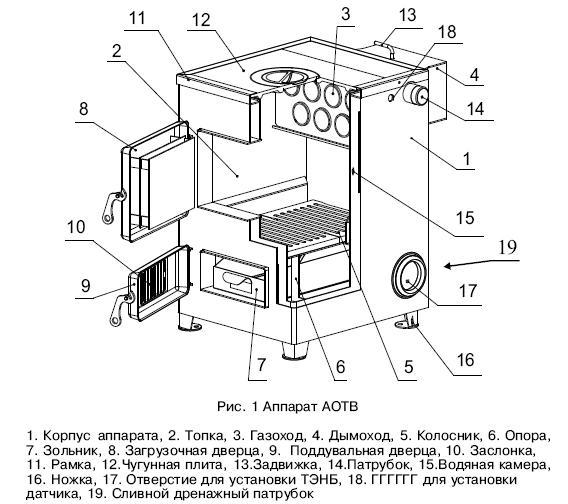
Chimney assembly
Systems of insulated and single-walled chimneys are assembled using the pipe-to-pipe method. In order to prevent tarry emissions and condensate from flowing into the pipe, the steel chimney is assembled using the "condensate" method. The vertical parts from the tee are also collected "by condensate", and the elements between the heating equipment and the tee are collected "by smoke".

When making the channel sleeve, a gap must be left. When using sandwich elements, rivets or self-tapping screws must be used to fasten them.
Chimney fixing
- The fastening of single-wall chimneys is carried out at the rate of at least one fastening per one and a half meters. Fixing sandwich chimneys requires fixing each element. If the height of the pipe is more than one and a half meters above the level of the roof, it is necessary to install a brace.
- The final stage of the do-it-yourself installation is the installation of a deflector or fungus on the top of the chimney pipe.
Before you start operating a self-assembled chimney for a solid fuel boiler, it is better to additionally check that everything is properly prepared: the protective film must be removed and the gate open.









